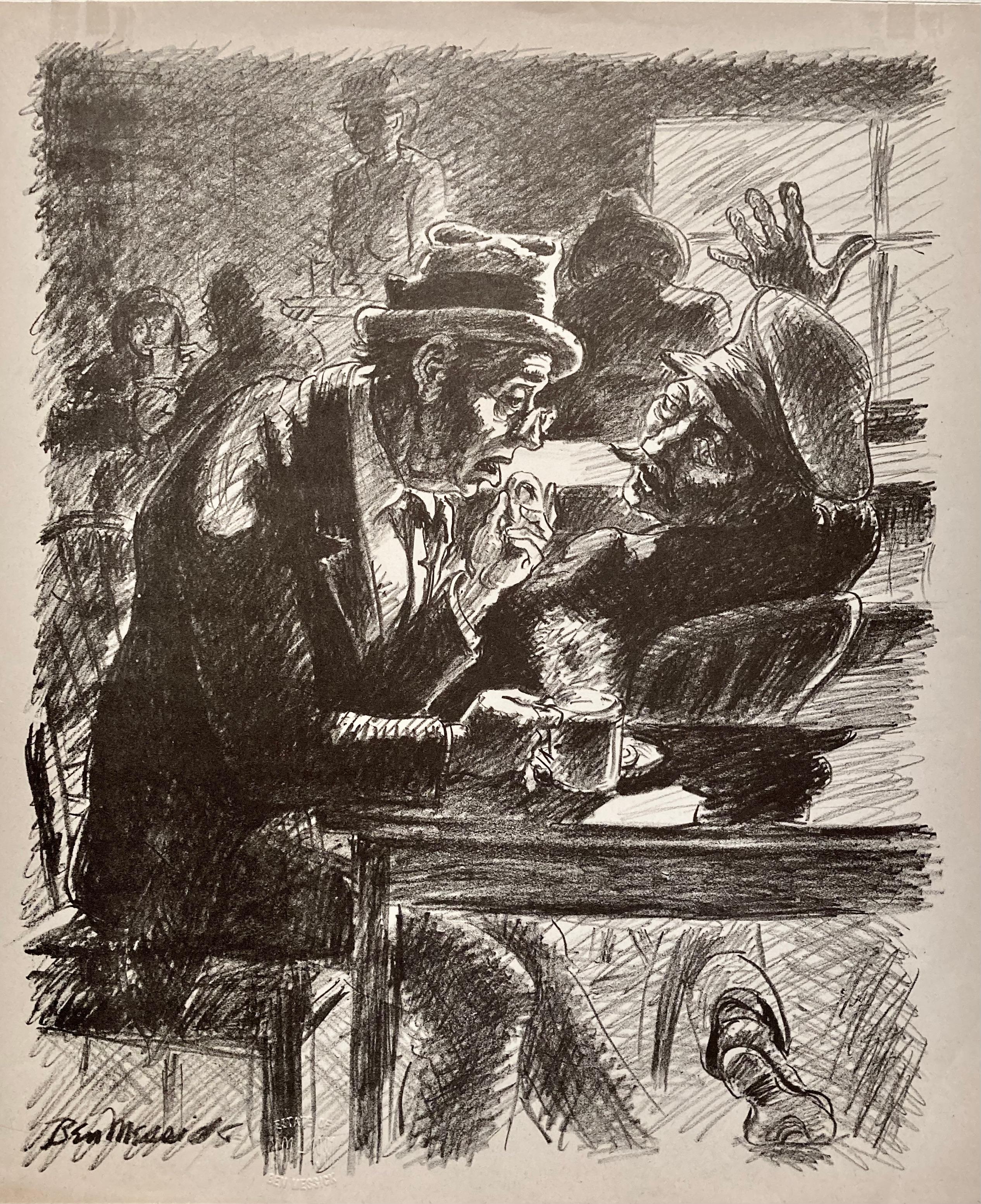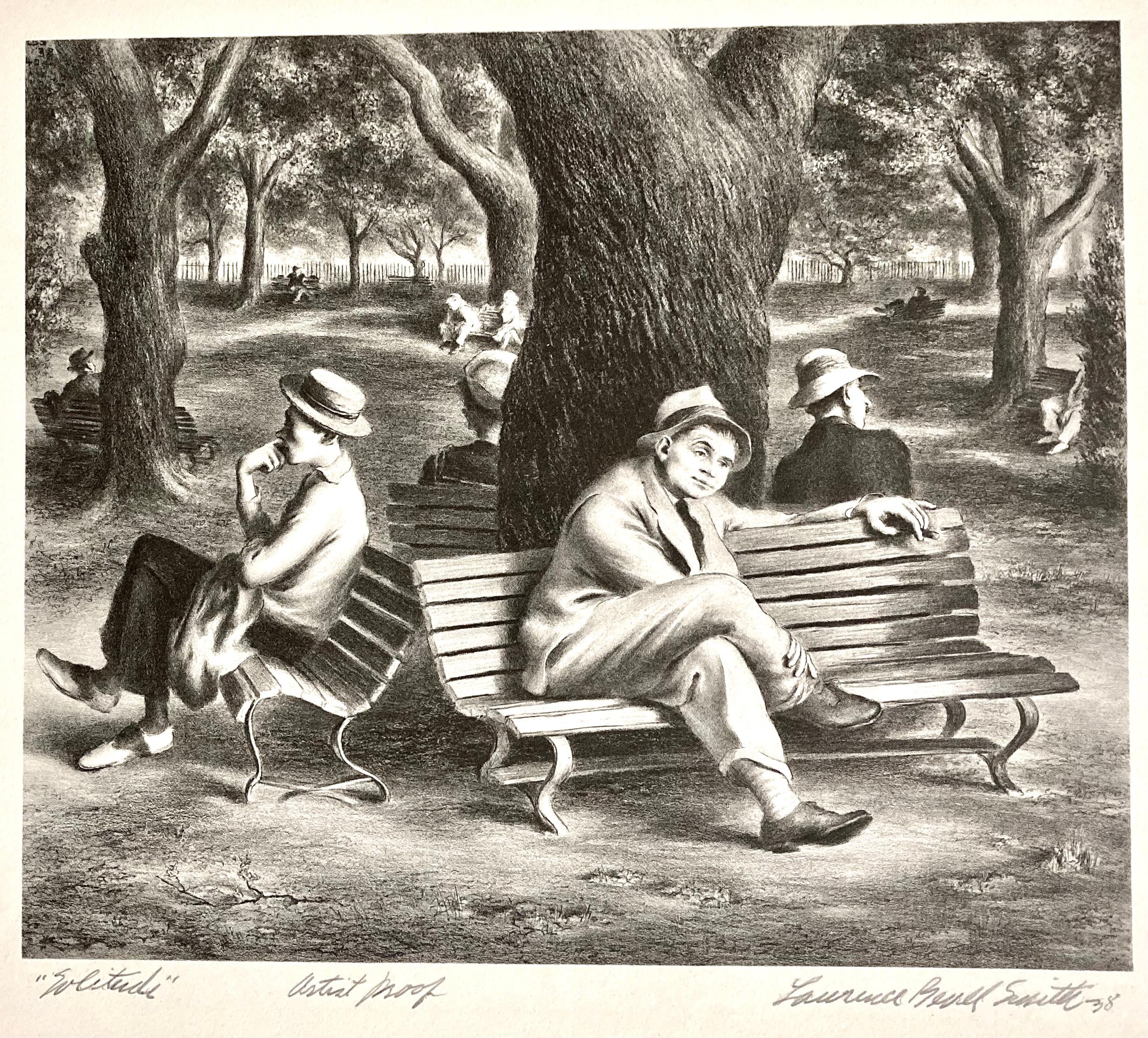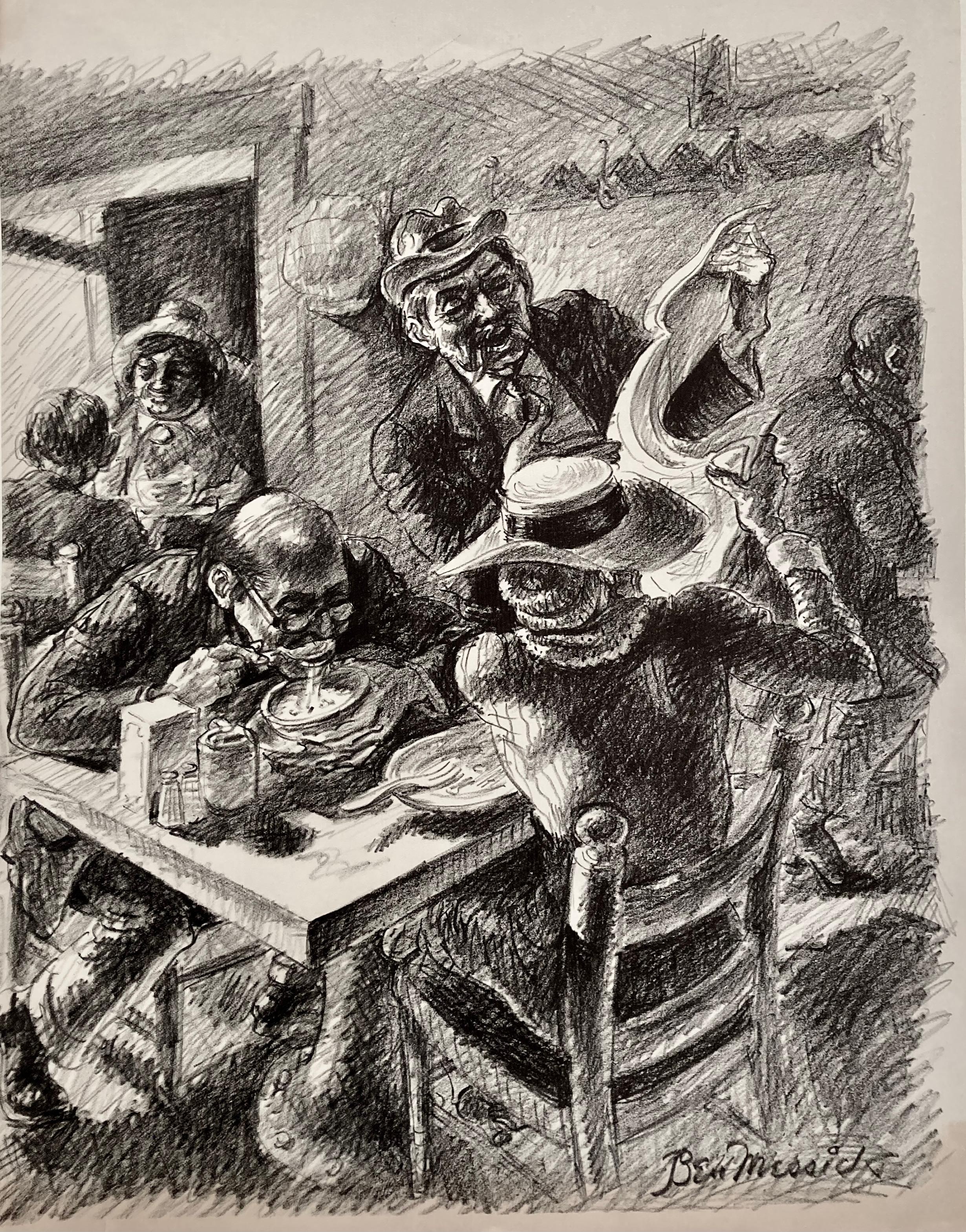Items Similar to 'Hurdy Gurdy Ballet' — 1920s New York — American Scene
Want more images or videos?
Request additional images or videos from the seller
Glenn O. Coleman'Hurdy Gurdy Ballet' — 1920s New York — American Scene1928
1928
About the Item
Glenn O. Coleman, 'Hurdy Gurdy Ballet', lithograph 1928, edition 50. Signed, dated, and numbered '14/50' in pencil.
Titled in the bottom left margin, in another hand. Numbered '14' in the lower right sheet edge, in pencil. A fine, richly-inked impression, on cream wove paper, with wide margins (1 1/4 to 2 1/8 inches), in excellent condition. Image size 12 1/8 x 15 15/16 inches (308 x 405 mm); sheet size 15 1/2 x 20 1/8 inches (394 x 511 mm). Archivally matted to museum standards, unframed.
From the portfolio 'Lithographs of New York' — 12 lithographs printed by master lithographer George C. Miller, exhibited at the Whitney Studio Galleries, November 1- 24, 1928.
Exhibited: 'A Century of Creativity: The MacDowell Colony,' 1907-2007, Library of Congress, February – August 2007. 'Life of the People: realist prints and drawings from the Ben and Beatrice Goldstein Collection,' 1912-1948, Library of Congress, 1999.
Impressions of this work are held in the collections of the Addison Gallery of American Art, Brooklyn Museum, Detroit Institute of Arts, Philadelphia Museum of Art, Library of Congress, The Phillips Collection, and the Whitney Museum of American Art.
ABOUT THE ARTIST
Glenn O. Coleman’s career (1887-1932) as a celebrated New York illustrator, painter, and printmaker was a short one. Born in Ohio in 1887, he grew up in Indiana and arrived in Manhattan in 1905 to attend the New York School of Art, studying under William Merritt Chase, Robert Henri, and Everett Shinn.
Coleman earned a name for himself in the 1910s and 1920s city art scene with his personal depictions of street life and working-class people. His illustrations (some of which he produced as lithographs) and paintings reflected the subject matter of his Ashcan teachers: Bowery bums, election night bonfires, slum kids, cops, criminals, “silk-hatted tourists,” bar stool sitters, and other denizens of Lower Manhattan’s corners and hidden enclaves.
In 1910, Henri said this about Coleman, who was exhibiting a series of drawings in New York called 'Scenes From the Life of the People' “This work of Coleman’s is no confection of art junk….It is the record of a certain life drama going on about us here in New York—one side, very grim—a side shunned by many, but one he has looked upon frankly with open eyes and has understood as the thinker with human sympathy understands.”
Coleman stated that his art is inspired by his personal vision of beauty, “Sometimes it is a mad beauty, sometimes a powerful and terrible beauty, sometimes a happy and refreshing beauty. I do not think one thing is more beautiful than another, that is, when I see each thing in its own place.”
A contributor to the socialist journal 'The Masses' and participant of the groundbreaking Armory Show in 1913, Coleman exhibited widely, but he was never very financially successful. “He gained first-hand acquaintance with the experience of the urban poor: often penniless, he frequently was forced to forgo painting in order to work menial jobs to support himself,” according to Fine Art Limited.
“In the mid-1920s, Coleman’s focus as a painter shifted away from the social environment of the city toward a preoccupation with such formal concerns as the geometry of its massive new architecture,” wrote Fine Arts Limited. “Just as his paintings assumed a more modernist style, however, he returned to his earliest sketches of the city as a basis for a series of more conventionally realistic lithographs that celebrate street life and the city’s ordinary inhabitants.”
At some point in the 1920s, he relocated to Long Beach on Long Island, continuing to paint his inspired depictions of New York City. His work won prizes and was acquired by museums like the Brooklyn Museum and the Whitney. In a 1910 magazine article, Coleman said: “My pictures may not be exactly like New York life really is—photographically speaking. Who really knows how New York life really is? I have my vision of it, my thoughts, my ideas of it….So these masks of men and women—these disguises of men and women, these curious shapes and forms, these shadows and masses of buildings are images always on my mind and out of these images my pictures are made because they are wonderfully absorbing to me, and because they have this terrible energy of New York life.”
- Creator:Glenn O. Coleman (1887 - 1932, American)
- Creation Year:1928
- Dimensions:Height: 12.13 in (30.82 cm)Width: 15.94 in (40.49 cm)
- Medium:
- Movement & Style:
- Period:
- Condition:
- Gallery Location:Myrtle Beach, SC
- Reference Number:
About the Seller
5.0
Recognized Seller
These prestigious sellers are industry leaders and represent the highest echelon for item quality and design.
Platinum Seller
These expertly vetted sellers are 1stDibs' most experienced sellers and are rated highest by our customers.
Established in 1995
1stDibs seller since 2016
256 sales on 1stDibs
Typical response time: 1 hour
Associations
International Fine Print Dealers Association
- ShippingRetrieving quote...Ships From: Myrtle Beach, SC
- Return PolicyA return for this item may be initiated within 7 days of delivery.
More From This SellerView All
- The Sixth Avenue Spur, New York City — 1920s American ExpressionismBy Frederick K. DetwillerLocated in Myrtle Beach, SCFrederick K. Detwiller, 'The Sixth Avenue Spur, New York City', lithograph, 1924, edition 20. Signed, dated, titled, and annotated 'Lith 20' in pencil. Inscribed 'To my Friend Herbert L. Jones' in pencil. Signed and dated, in the stone, lower right; initialed and dated '1927' in the stone, lower left. A fine, richly-inked impression, on cream wove paper, with margins (7/8 to 1 1/4 inches); slight toning in the top left sheet edge, otherwise in good condition. Scarce. Image size 20 1/2 x 14 inches (521 x 356 mm); sheet size 22 1/2 x 16 inches (572 x 406 mm). Archivally matted to museum standards, unframed. ABOUT THE IMAGE The Sixth Avenue El was constructed in the late 1870s by the Gilbert Elevated Railway and reorganized as the Metropolitan Elevated Railway. By 1878, it was running from Rector Street to 58th Street. Soon after that, it was taken over by the Manhattan Railway Company, with three other Manhattan elevated train lines. The company built a connection, the ‘spur’ by which it turned west on 53rd Street to merge with the 9th Avenue El—paralleling the present-day route of the 6th Avenue subway. The Sixth Avenue El served the “Ladies Mile” shops (including the Siegel-Cooper emporium, whose building now houses Bed...Category
1920s Ashcan School Figurative Prints
MaterialsLithograph
- 'A Morning in May' — 1930s Social Realism, New York CityBy Reginald MarshLocated in Myrtle Beach, SCReginald Marsh, 'A Morning in May', etching, 1936, edition 100 (Whitney, 1969), Sasowsky 169. Unsigned as published; numbered '89/100' in pencil. A superb, richly-inked impression, ...Category
1930s Ashcan School Figurative Prints
MaterialsEtching
- New Year’s Eve and AdamBy John SloanLocated in Myrtle Beach, SCJohn Sloan, 'New Year's Eve and Adam', etching, 1918, edition 100, (only 85 printed), Morse 190. Signed, titled and annotated '100 proofs' in pencil. Signed and dated in the plate, l...Category
1910s Ashcan School Figurative Prints
MaterialsEtching
- 'Locomotives Watering' — 1930s Social RealismBy Reginald MarshLocated in Myrtle Beach, SCReginald Marsh, 'Erie R.R. Locos Watering (Locomotives Watering)', etching, 1934, edition 100 (Whitney, 1969), Sasowsky 155. Unsigned as published; numbered '68/100' in pencil. A su...Category
1930s Ashcan School Figurative Prints
MaterialsEtching
- From the Sea (From the Sea—Pieta)By Benton Murdoch SpruanceLocated in Myrtle Beach, SCA superb, richly inked impression, on off-white wove paper; the full sheet, with deckel all around (margins 1 to 2 inches) in excellent condition. Signed, dated, titled and annotated...Category
1940s American Modern Figurative Prints
MaterialsLithograph
- NeroBy Benton Murdoch SpruanceLocated in Myrtle Beach, SC2-color lithograph, edition 35, 1944, Fine and Looney 233. Signed, dated, titled and annotated 'Ed 35' in pencil. Initialed 'BS' in the image, lower right. A superb, richly inked im...Category
Mid-20th Century American Modern Figurative Prints
MaterialsLithograph
You May Also Like
- Ann Michalov, A View of the ParkLocated in New York, NYOriginally from Illinois, Ann Michalov worked in Spokane, Seattle and Portland, where she finally settled. This lithograph however really looks very like New York City's Central Park...Category
1930s Ashcan School Landscape Prints
MaterialsLithograph
- Ben Messick, Coffee and Donuts (Sinkers & Java)By Ben MessickLocated in New York, NYBen Messick perfectly captures the world of the 'Ashcan' period: Everyday life, local characters, people we could still meet today. He could draw like a son-of-a-gun! The date of 194...Category
Mid-20th Century Ashcan School Figurative Prints
MaterialsLithograph
- Lawrence Beall Smith, SolitudeBy Lawrence Beall SmithLocated in New York, NYLawrence Beall Smith draws four men in a park, each with his back to a giant, strong tree. The year is 1938 and the country is coming out of the Depression but World War II is alread...Category
Mid-20th Century Ashcan School Landscape Prints
MaterialsLithograph
- Ben Messick, (The Newspaper Story)By Ben MessickLocated in New York, NYBen Messick perfectly captures the world of the 'Ashcan' period: Everyday life, local characters, people we could still meet today. He could draw like a son-of-a-gun! And this is a v...Category
Mid-20th Century Ashcan School Figurative Prints
MaterialsLithograph
- John W. Gregory, AquariumBy John W. GregoryLocated in New York, NYGregory often worked in lithography, probably learned at the Art Students League in New York City. In all likelihood this is a New York scene but he also often drew New England subje...Category
1930s Ashcan School Landscape Prints
MaterialsLithograph
- Theresa Halat, (The Fox and The Dog)Located in New York, NYWhile nothing is known about this artist (maybe even the spelling of the last name?), the drawing is so skilled and the composition compelling that there MUST be other work! And use ...Category
1930s Ashcan School Animal Prints
MaterialsLithograph
Recently Viewed
View AllMore Ways To Browse
Bar Scenes
1920s Inspired
1920s Beauty
1920s Modernist
Printed Stools
1920s Long Island
Mens Silk Print
Phillip Paper And Ink
1920 Beach Scene
Ballet Silk
Ashcan Urban
Art School Stool
Architectural Pencil Sketches
Kids On The Beach Paintings
Robert Indiana Lithograph
Midcentury Sketch Of Women
Bar Stools Cream
Massive Men




